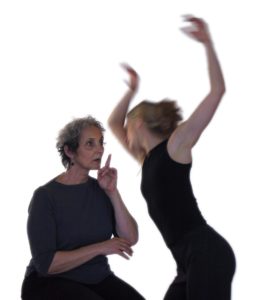A Conversation: Crystal Pite and Lynda Raino’s 2004 duet between friends - Vancouver Ballet Society
- Home
- Features 2020 - 2023
- A Conversation: Crystal Pite and Lynda Raino’s 2004 duet between friends

By Robin J. Miller
Ask anyone who saw A Conversation at its premiere in April 2004, at the McPherson Playhouse in Victoria, BC, and I guarantee they will remember it. Not every detail, of course, after so many years, but at least a few indelible images: a silver teapot, china teacups, oddly sized wooden tables, lots of talk, lots of laughter, a whiff of sadness and two dancers, different in every way — age, size, flexibility, speed — yet also alike in their movement quality and ability to delight an audience.
A Conversation was the first commission made by Dance Victoria. It came about when the organization’s executive producer, Stephen White, was riding in a cab one day with Crystal Pite and casually asked her what she would like to do if he could come up with a little bit of money. Her response: “I’d like to work with Lynda Raino.”
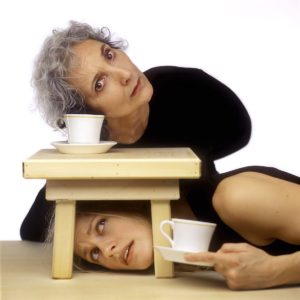
Raino at that time was 56, with a back injury that was hurtling her reluctantly toward the end of a long career in modern dance performance and teaching, largely in Victoria, where she had lived since 1979, raising her two children as a single mother. She was a late bloomer, only starting to dance at age 18, but within a few short years winning a scholarship to train at L’École supérieure de ballet du Québec in Montreal. Just as quickly, however, Raino realized that a solo career was her only viable route: “I’ve got bow legs, flat feet, broad hips,” she told me with typical earthy frankness in an interview for The Dance Current in advance of A Conversation’s premiere, “and I’m a rebel.” Her choreographic work, based largely in the everyday and the literal — a mother folding diapers, a two-year-old’s slightly jaundiced perspective on the world — reflected that same earthiness.
Pite, on the other hand, was 33. After 13 years performing with Ballet BC and then William Forsythe’s Ballett Frankfurt, Pite was choreographer-in-residence with Les Ballet jazz de Montréal and already a prize-winner known for quicksilver, fiercely intelligent and rigorous works that, while they share some of the same heart and humour, were more or less the antithesis of Raino’s. She was also in the midst of working with her own newly created Vancouver-based company, Kidd Pivot. She took on the Dance Victoria commission because, though she had grown up in Victoria and seen Raino’s solo work, she had never trained with her. “I sensed that I could learn from Lynda as a senior artist,” Pite told me in 2004. Even more important, said Pite, “she’s also hysterically funny.”
During a free-ranging hour-long Zoom call in December 2020, just a few days after Pite turned 50 (Raino is now 72), the two artists, who have remained firm friends, talked with me and each other about their experiences before, during and after their collaboration.
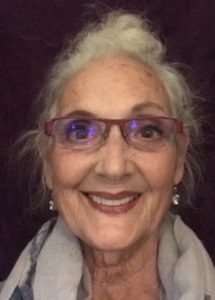
For Raino, A Conversation remains a bittersweet memory. As her farewell to dance performance, it felt tragic, yet it was also “such a great gift.” Not intended to be “a poor Lynda” piece, as Pite said at the time (and it wasn’t: it was hilarious — when at one point Raino used a block and tackle to get her leg up in the air, it must have taken five minutes for the audience to stop giggling), it was still, said Raino, “about how Crystal had no idea what was ahead of her, while I knew what was behind me and we were in these two very different places in our lives.”
Talking directly to Pite, she continued, “I mean, it’s really not fair to say you didn’t know what was ahead of you, but you weren’t aware in the way that I was about all of the stuff that’s coming. It’s like asking a ten-year-old what they’re going to be like when they’re 15 and they can’t even imagine it because it’s too far away. The 30-year-old’s mind, the 30-year-old’s body, the 30-year-old’s opportunities — there is nothing stopping anything at that age, but it starts to go. Just the energy, the energy that it takes to keep that machine going at the same pace can become too much, and then the desire may shift and you might not want to keep up that pace. And the horror that brings: it’s my life, it’s my identity, I can’t step back. Now that you’re 50, I suspect you are getting glimmerings of that.”
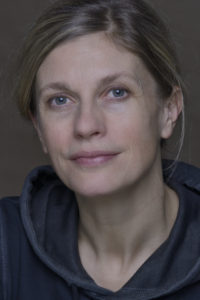
“Maybe,” Pite responded, “but it was a bit of a different journey for me. You’re right that when we did A Conversation, I was in my early 30s and, yeah, feeling like I was in my full force — at the height of my ability as a dancer, I guess. But I remember I was also bringing the two aspects of myself, the dancer and choreographer, together for the first time. It was early days for the company [Kidd Pivot] and I had started to perform only in my own work.” No longer a company dancer, she was now able to set her own schedule and choose her own projects. One of the “great joys” of that period was being able to say “I want to have an experience of learning and performing with Lynda. And I had the freedom to do that because I was my own boss for the first time.”
But Pite’s days as a dancer were, unbeknownst to her, already limited. She stopped dancing at 40, when she had a baby. “You had already had your babies and they were all grown up by the time we met and were performing A Conversation together,” she told Lynda. “So you had a really different relationship to that balance between motherhood and your dancing. You had gone through that so much sooner and somehow managed to raise your kids alone and still be a dancer for so many years. For me, having a baby was the end point of my dance career. I always knew that. I always knew my dance career would be ended either by an injury or a baby.”
Pite understood that “I could be a mom and a choreographer, or I could be a mom and a dancer,” but not all three, “especially since, at that time in my life, at 40, I was already facing a lot of issues in my body that were taking a lot of time to contend with.” She also had more confidence and belief in herself as a choreographer than she ever did as a dancer, so “it felt like a natural choice to focus on creating and making things and being a mom.”
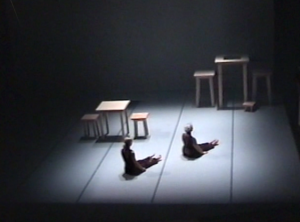
Before then, however, back in that halcyon time when Pite was still dancing, Kidd Pivot was beginning its rise and A Conversation was taking shape — when “I was trying to learn as much as I could learn and have great experiences on stage” — Pite was already aware of a reality that runs through her work to this day: the ephemeral nature of dance. “As a dance artist,” she said, “you’re always living in this kind of heightened awareness of the present moment because our art form is always disappearing. You don’t really have any artifacts to hang on to” — like a painting or a poem — “and I think as dancers we’re hard-wired to be aware of that, to understand how precious the present moment is.”
In A Conversation, the fleeting nature of dance and the inevitability of loss were reflected in two ways. In dialogue, with the dancers comparing memories of the pieces they had performed, including Raino’s Mother Moon, in which she executed a deep backbend while heavily pregnant at about the same as Pite was appearing in a school recital as Little Bo Peep. And in movement, where Pite dispatched what Jennifer Van Evra described in the Vancouver Sun as “motions so fluid that it looks as if she’s made of mercury,” while Raino remained grounded, her power coming through being a performer of long and deep experience rather than through the range or quickness of her body.
Though it was Raino who was ostensibly leaving the stage forever (while she did indeed leave dance performance in 2004, she has gone on to act in both theatre and film, to co-found a popular singing group called The Millies and to choreograph a wildly successful annual fashion show fundraiser for Dance Victoria), the idea of ephemerality was a new concept for her.
“I didn’t quite get that in my own world,” Raino said to Pite. “I truly thought that it would just go on forever until I said I’ve had enough. It never really occurred to me than an injury would take me out. When you would talk about the fact that a piece could never really be the same twice, I thought, yeah, but it’s close. And that was enough for me. I think that’s really the difference between the way you think and the way I think. I felt like I was just blobby me, in my body right here, concerned just with what we were doing then, while you were seeing much bigger pictures in your mind. I was in awe of your brain. It’s very different from mine.”
But Pite was also in awe, she said to Raino, “in awe of your courage and your humour and how quickly you could assimilate something we were working on, but also be ready to move on. I found that incredible.” She also found collaborating with Raino — even though they are both control freaks and “very bossy,” said Pite — far easier than she has found choreographing any of her works since then.
“A Conversation was a great opportunity for me to bring myself as a performer and as a choreographer together,” said Pite. “I hadn’t been able to do that a lot at that point, and to do it with Lynda, in my hometown, while I was staying with my parents, was really nice. I don’t remember it being stressful. Most of the time when I look back on the things that I’ve created I remember an enormous amount of stress and doubt and actual terror. I don’t recall that with this one. I’m sure we must have had our moments, but mostly I found it effortless and fun, like a conversation can be between friends.”
Lynda remembers it that way, too. “We didn’t have doubt,” she said. “It was just so cool — two brains saying I think we should start here, or I think we should do this. It was effortless and I think that’s why for me it is one of my absolute most special pieces.”
“Lucky us,” responded Pite, with a smile.
